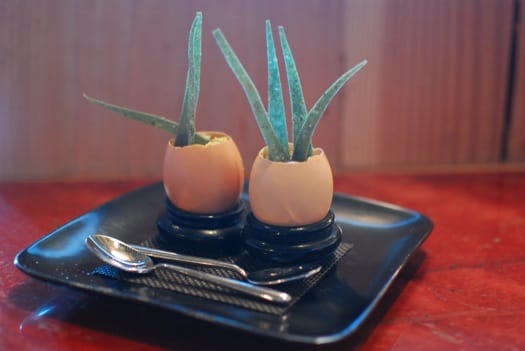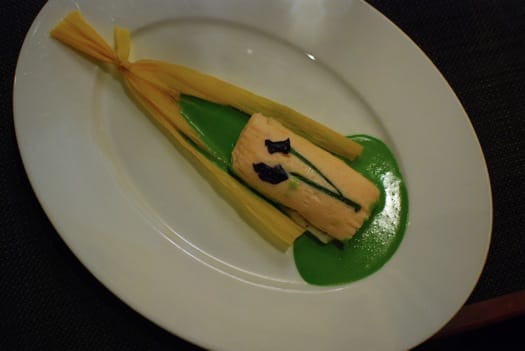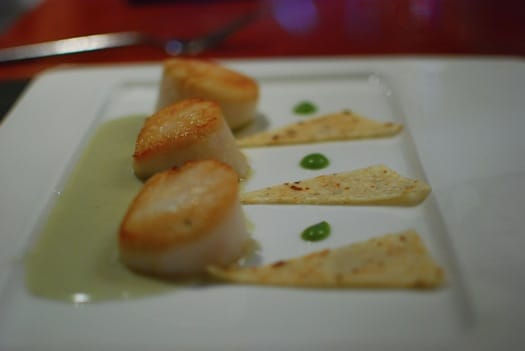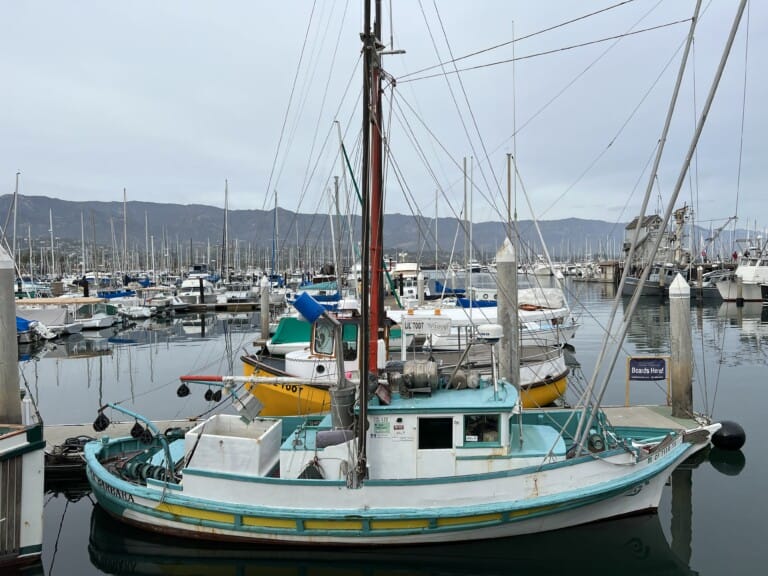In an unlikely twist, September 1 marks the return of Saint Estèphe, the bygone Manhattan Beach restaurant from Chef John Rivera Sedlar and sommelier Steve Garcia that debuted in 1981 and drew on Sedlar’s New Mexico roots to help define an entire genre. Now, for the 30 days of September, Chef Sedlar is once again cooking many of those dishes at Rivera to commemorate the 30th anniversary of Saint Estèphe’s landmark South Bay debut.
On August 26, Chef Sedlar hosted a group of media types, me included, as we previewed the menu and wine director Ben Broidy’s pairings, which also derived from the Southwest (France, that is). He sourced from Bordeaux’s left bank all the way to Cotes du Roussillon, where the people evidently don’t consider themselves French or Spanish. It’s a world apart.
Broidy made one exception, turning to Sedlar’s home state for bottles of 2007 Gruet, a sparkling wine from Albuquerque. Guests enjoyed pours as people filed into Playa Bar’s square communal table, which was splayed with copies of Sedlar’s influential cookbook, Modern Southwest Cuisine.

The Kachina Mosaic of American Caviar depicted the face of a Native American person using scrambled egg yolks and whites, chopped raw onion, salmon roe, green tobiko and black caviar, which served as the eyes and mouth. Diners had the option to pile the ingredients onto toast points or endive. Either way, servers recommended a squeeze of lime and a drizzle of crème fraiche.

Scrambled Huevos Rancheros was inspired take on a Mexican breakfast classic, with shells filled with jalapeno-spiked scrambled eggs, Chevre and blue corn tortilla “arrows.”

The dish that Chef Sedlar used to serve as an amuse bouche at Saint Estèphe, “fireworks,” involved decorative (and edible) squiggles of avocado and red chile, red corn, tomatoes and star-shaped tortilla chips.
Chef Sedlar stuffed his facedown chile relleno with mushroom duxelles and plated it with garlic chevre sauce and chile lightning bolts that represented New Mexico’s storms.

A salmon mousse tamale lined with a thin layer of firm masa appeared in a corn husk with cilantro sauce. The edible flowers appeared to foreshadow the rise of Rivera’s tortillas florales.

Salmon lattice topped tangy salsa verde and accompanied sweet parsnip roses.

Scallop “nachos” rested on Roquefort cheese sauce.

Sedlar’s palate cleanser was red cactus pear granite with dry vermouth, which arrived in a champagne flute. He finished with a pair of desserts, including Neon Tumbleweed, a colorful depiction of the desert involving papaya, kiwi, strawberry and raspberry sauces, fresh fruit and cinnamon cacti cookies.

Blue cornmeal crepes with canela (cinnamon) ice cream and grapefruit Grand Marnier sauce concluded the meal. Well, the plated concluded our consumption, though after dinner, Chef Sedlar and chef de cuisine Joe Panarello left the kitchen and shared insights about working on the Saint Estèphe menu.
You were saying that you’ve been figuring out the roots of where everything came from.
Sedlar: Our roots, especially in terms of the Latin food menus we’ve developed, and the 3000 year culinary story, for me it began in the Southwest with the story of tortillas and corn, and it was really the first baby steps in what was really earthy, nourishing, straight forward, good food and now you and I have seen 30 food revolutions in the last 10 years alone, so as we look back, we said, “Well, that really had a lot of legs at that time.” And where did that influence come from? Not only from me, but it was really was from Fernand Point.
How did you decide which dishes to serve? You must have served dozens and dozens of dishes during the course of the restaurant’s run.
Sedlar: Yes. That was sort of an iconic seminal menu of the whole Southwestern genre that we were cooking. Joe got angry at me because I chose a lot of salmon dishes.
The menu is so beautiful. When you read Mexican food terms or Southwestern in the French language, it changes how your brain processes, but it sounds very floral and just rolls off your tongue. It’s very beautiful. We didn’t have the confidence. When we were young, we would eat burritos, my parents would say, “Hide, don’t let the Anglos see you eating burritos.” It was very much a second class cuisine, and that was sort of the impetus to raise the level of the knowledge about that kind of cooking.
Escoffier was a little bit more heavy, and Fernand Point dictated some new rules about lightness, about freshness, about Nouvelle cuisine. I was definitely from the school about Nouvelle cuisine. Joe’s a little younger, so he came a little bit after that. Things like putting the sauce under – you don’t remember – you don’t remember that we didn’t have goat cheese. Then all of a sudden the it ingredient was Laura Chenel goat cheese, and all across the city, chefs were cooking with goat cheese, and we ended up with six or seven dishes, where today we’d go, “There’s too much goat cheese on this menu,” but then people wanted to have some distinctive California ingredients. You won’t remember that all the foods were topped with sauce. Everything was on top and then became under the ingredient. Everything was overcooked, but it became more undercooked and more nourishing and more colorful. All of a sudden people were cooking and serving food on big white plates. Everybody before was serving food on small plates. So there were a lot of major shifts that we just take for granted.
How do you feel cooking these dishes again?
Sedlar: As we’re preparing and sending them out, I think that they’re holding up very well. We were surprised. We thought they’d be dated. Why are we doing this? As you know, Joe sometimes asks me why I decide to include a certain dish in a progression of courses, and it’s really about the whole narrative and historical viewpoint. We kind of cook in stories. We’ll do a meal of a whole entire story, or a menu of a whole entire story. It’s not so much about the individual components. It’s about the whole narrative. I think it fits very well today and how people are cooking.
Did anything surprise you in this process, Joe?
Panarello: No, I just think it’s a great honor working with chef. This is a timeframe. You go back in a journey and see how food was back in a certain time period. When I was going to culinary school, this food was just coming out of what it was, the basis for a lot of things. To see like the squigglys on the plate, using the squeeze bottle, this is where it all started, and to go back and see that history and how food evolved, it’s a great honor for me. A lot of chefs can go work with whoever, all the molecular gastronomy, but to go back to the basics and the roots and enjoy the history and the culture of food, I think that’s what separates chefs apart. I enjoy working with Chef John and that’s why I enjoy doing this dinner. To me some of the food seems a lot more simple, because it was very easy preparations, salt, pepper, making sure everything’s cut beautifully, simple, sophisticated, it’s just the core, it’s awesome to see, awesome to do.
I thought it was interesting to see your messages on the plate, the Southwestern designs, like the lightning bolts and the face.
Panarello: That’s an important example of that. Chef evolved. It’s incredible because now he’s got spiceology, but before, he was talking about mountain ranges with the blue tortillas and yucca. He told the story in a different way, and you could just see the progression of food and how he found his realm. It fit like a glove and he started growing and growing and growing. Now we have Reflexiones at Playa. It’s an awesome experience to see how he keeps building and building, and how food evolves and can get better and better.
Note: Rivera comped my Saint Estèphe meal as part of a media preview.









Leave a Comment